It Took a Pandemic to See the Distorted State of College Sports
In 2020, COVID-19 laid bare the harsh reality of the NCAA: Revenue sports don't prop the whole thing up—they *are* the whole thing.
If all of 2020 felt like one long Zoom meeting, college sports logged in late and hungover, wearing expensive but stained pajamas, in an enormous but filthy house, leading everybody else to ask: You live like that?
Yes, indeed. This was the year when athletic departments exposed themselves for what they really are: large businesses covered in nonprofit wrapping paper.
A coronavirus pandemic forced the whole enterprise to announce its priorities, which are even more skewed than we realized. There are thousands of people working in college athletics with excellent priorities, of course—people who value academics, relationships, integrity and personal growth. But those are not the qualities the NCAA system rewards. College sports, purportedly a celebration of amateur athletics, are an exercise in big squashing little: large conferences whipping small ones, and revenue sports hogging resources from nonrevenue sports.
Mark Twain famously said that he wanted to be in Cincinnati when the world ended, because it would happen later there. But to see the distorted state of college sports in 2020, go straight to Cincinnati. In April, with the financial reality of a national shutdown settling in, the state university decided to cut its men's soccer program, saving $726,498. In August, the school bumped football coach Luke Fickell's annual salary up from $2.3 million to $3.4 million. In December, the football program was put in its place by the sport's biggest sharks: Despite being undefeated, the Bearcats had no real chance of making the College Football Playoff ahead of Power 5 schools, which control the process.
College football stars famously begged to play despite the raging pandemic, and the individual decisions to proceed with games were often framed as giving players that opportunity. But as with most principles in college athletics, "giving athletes the opportunity" was applied selectively this year, at the discretion of those in charge.
Some coaches and administrators portrayed themselves as protectors, keeping players safe from the virus and from the sort of outside influences they would purportedly encounter if they were sent home—but only the gullible believed that. Many players got the virus anyway. The NCAA moved fall championships in cross country, soccer, field hockey, women's volleyball and men's water polo to the spring. Football stayed in the fall because that's where TV networks wanted it, and basketball remained a November-to-March enterprise, despite public urging from Hall of Fame coaches Mike Krzyzewski and Rick Pitino to delay the season. The NCAA is terrified of losing March Madness (and the revenue it brings in) again. Duke had to make decisions that basketball's overseers would not: The women's team opted out of its season, and the men's team cut short its nonconference schedule.
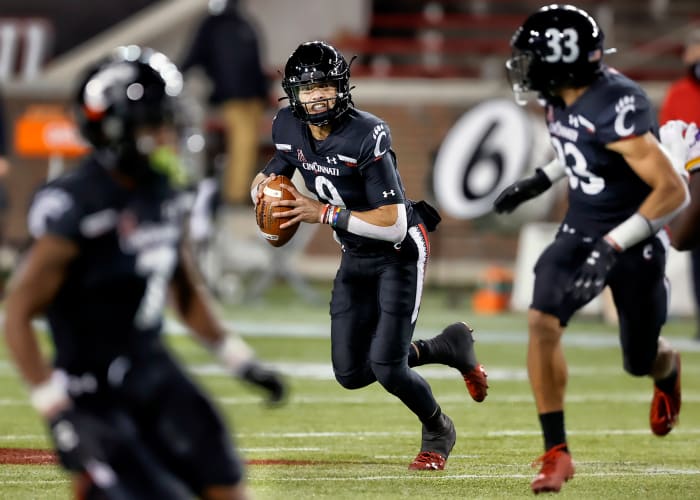
Cincy finished 9–0 but won't sniff the College Football Playoff—how's that for egalitarian?
David E. Klutho/Sports Illustrated
Universities are supposed to practice egalitarianism, or at least aspire to it. Future CEOs and artists share a campus, and that coexistence is an essential piece of the experience. This is especially true at state flagship universities, which are (or at least aspire to be) magnets for the finest students from all over the state.
And college athletics are supposedly the sporting version of this. For decades, administrators insisted that monetizing football and men's basketball was a means toward a larger, more noble end: funding other varsity sports. As those NCAA commercials love to remind us, the overwhelming majority of athletes "go pro in something other than sports."
In 2020, though, it became obvious that the apparatus that was supposed to support a larger infrastructure has overwhelmed it instead. Around the country, schools responded to their budget crunches by slashing nonrevenue sports, like huge law firms deciding to cut costs by slashing pro bono work.
College sports have been a hypocritical enterprise for a long time; any sober assessment of the last half-century reached that conclusion. But now hypocrisy is part of the mission statement. Football has been stripped down to what it really is: lucrative TV programming. In 2020, it didn't matter whether playing was safe for surrounding communities or even whether students were on campus.
In recent years, University of Michigan regent Jordan Acker voiced his support for athletes controlling (and profiting) off their names, images and likenesses. This past year convinced him that structural hypocrisy runs even deeper than he realized. As Acker watched a Big Ten football player get injured on TV this fall, in an empty stadium, he had a flashback to his own shoulder injury in high school.
"The first thing I wanted was to see my parents," Acker says. "I'm sure that kid felt the same way. And he couldn't [see them]. And he was only playing that game, in a city and in a state that was effectively shut down because of the pandemic, because the Fox contract required him to do so. I could no longer, in my mind, justify the fiction.
"It just doesn't make sense anymore to pretend like this is something other than what it is. My colleagues might disagree with me. I'm sure the [Michigan] administration disagrees with me strongly. But we have to accept what college football is. The veneer has been entirely stripped away. It's gone."
The Ivy League was the first conference to cancel its men's and women's basketball tournaments, in March, and it has consistently canceled and postponed events ever since. In November, the conference axed its winter-sports season and vowed not to stage any events until at least the end of February. These decisions have been portrayed as proof that the Ivy League is taking the pandemic seriously, or confirmation that sports aren't important to the Ivies. The thinking behind the decision, though, was simpler and far more revealing. In the Ivy League, sports—from football to fencing—are student activities, subject to the same rules and regulations as any other student activity. Traveling from campus to campus to play sports was incompatible with COVID-19 restrictions.
"While the decision was clear, it's still painful," says Ivy League executive director Robin Harris. "We spent countless hours working with our athletic directors and coaches since March—looking at schedules, looking at protocols, looking at ways we can conduct athletic competition. That included looking at different mitigation strategies for travel. We spent an inordinate amount of time [and presented] presidents with concepts and frameworks. They just felt like that would be inconsistent with campus policies. It was not a difficult decision."
This is a straightforward, fundamental concept: So-called "student-athletes" are students. As students in a pandemic, they receive the same benefits, protections, privileges and restrictions as other students. This is so indisputably aligned with the NCAA's official view of itself that in May, NCAA president Mark Emmert reiterated this seemingly obvious point, telling ESPN, "If a school doesn't reopen, then they're not going to be playing sports. It's really that simple."
One can question whether Emmert actually believed that, but ultimately his sincerity is irrelevant. He did not have the power to enforce that stance, and many NCAA member schools did not have the interest. In August, three prominent schools in the University of North Carolina system—UNC, NC State and East Carolina—sent students home after one week on campus. All three schools continued to play sports. UCLA decided to conduct "about 8% of fall-term courses in person or using a hybrid, with the remaining vast majority delivered remotely." Sports continued there as well.
As coronavirus cases spiked, numerous schools made similar compromises. When Santa Clara County, Calif., issued a regional stay-at-home order, Stanford sent its women's basketball team to Las Vegas for 17 days while the Cardinal men spent nearly two weeks in North Carolina. Michigan announced in November that "most undergraduates will be strongly encouraged to remain at their permanent addresses and access instruction remotely" for the winter semester, which has been pushed back until after Martin Luther King Jr. Day. Still, on Christmas Day, there was the school's men's basketball team, playing a game in Nebraska.
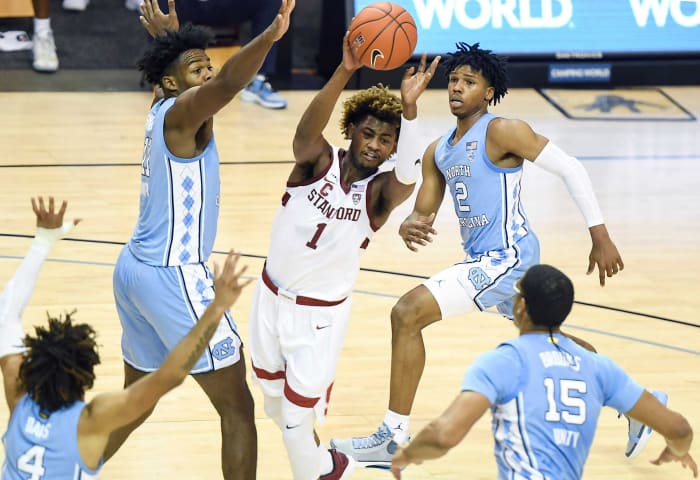
Stanford saw a stay-at-home order and instead made North Carolina a temporary home.
Angela Wilhelm/awilhelm@citizentimes.com/USA TODAY Network
The storyline of the fall was that daily rapid testing had made it safe to conduct sports, but there were two glaring flaws in that argument. One: It conveniently ignores Emmert's principle: If a school doesn't reopen, then they're not going to be playing sports. Suddenly, that didn't matter anymore. Schools quickly abandoned the notion that athletes are like other students—all over the country athletes received access to tests that the rest of their university communities lacked. They were prioritized not because they were at greater risk but because their presence was of greater financial value to their schools.
The other flaw in the argument that daily rapid testing made sports safe: "Safe" compared to what? To a broader society that botched coronavirus management all year? Safer than if athletes had been subject to the same rules and guidelines as other students? It is possible that the cases per capita within college sports will turn out to be lower than for the country as a whole, adjusted for demographics, but it is far too early to know that. It is highly likely, though, based on logic and on what we know about the virus, that all the travel involved in collegiate sports helped spread COVID-19 around the country.
We will likely not know for many years how this virus affects people long-term. We do know, however, that there were outbreaks in college sports—Houston men's basketball coach Kelvin Sampson, for one, said his entire team had COVID-19—and that, while some coaches and schools took protocols extremely seriously, others portrayed them as an annoyance.
"Not all of our players, but most of our players have caught it," LSU coach Ed Orgeron told reporters on the eve of the college football season. "I think that hopefully they won't catch it again, and hopefully they're not out for games."
When Florida State's medical staff advised its team to cancel a game with Clemson (allegedly because of a positive test by a Clemson player), Tigers coach Dabo Swinney complained, "COVID was just an excuse." And after Texas A&M beat Florida with 24,000 fans in 102,000-seat Kyle Field, Gators coach Dan Mullen made it clear that he'd had enough of social distancing. Florida governor Ron DeSantis had just loosened restrictions for crowds at sporting events, and Mullen saw an opening. "Hopefully the university administration decides to let us pack the Swamp for LSU next week … because that crowd was a major factor in the game," he said. "So I certainly hope our university administration follows the governor."
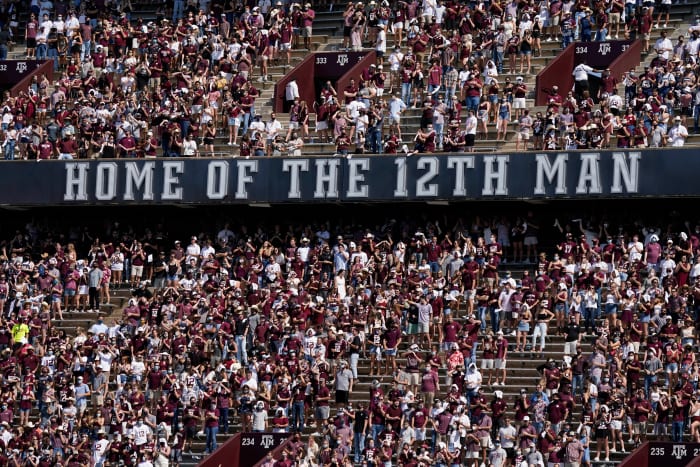
A&M's take on social distancing—24,000 fans, many with little separation—left Mullen envious.
Scott Wachter/USA Today Sports
Mullen later opened his weekly SEC teleconference with the ultimate fake-apology cliché: "I certainly apologize if I offended people." A few days after that, he tested positive for COVID-19. (The game was postponed following a Gators outbreak.) Two weeks after that, he responded to a brawl between his team and Missouri's by trying to fire up the crowd. And two months after that, he was cited for recruiting violations. The NCAA said Mullen "did not promote an atmosphere of compliance" and hit him with a one-year show-cause order, limiting his ability to recruit.
Failure to promote an atmosphere of compliance is supposed to be a serious charge from the NCAA, but in Mullen's case it barely caused a ripple. Administrators used to talk about having perspective. Now they brag about a lack of it. When the SEC boasts that in the South "it just means more," that's not a comment on GPAs. Earlier this month, Auburn decided to pay coach Gus Malzahn $21.45 million to go away. Athletic director Allen Greene explained the decision with words that are familiar to any observer of the coaching carousel: "We will begin a search immediately for a coach that can help the Auburn program consistently compete at the highest level."
Successful administrators understand that the most important part of their job—even more than winning football games—is appearing obsessed about winning football games. Customers want to know that whatever the team does, the school expects better.
Not everybody can win, but everybody can be obsessed, and everybody can market obsession. That is the prominent business model in college sports: Prove to your customers that you are as irrationally committed as they are. Schools are far more likely to be criticized for not paying obscene salaries to football coaches than for doing so. Which is why coaches' salaries keep going up. These investments are so speculative, and so detached from the underlying economics, that it feels foolish to call them investments at all.
According to a USA Today database, Vanderbilt paid James Franklin—the school's most successful modern-era coach—$1.84 million in 2013, his last season in Nashville. This year, Derek Mason, his much less successful replacement, earned $3.5 million. He also went 0–9 and got fired.
In December of 2010, Will Muschamp, a man with zero head-coaching experience, agreed to lead Florida for $2.75 million per season. He went 28–21 in four years, got canned, and took a $6 million golden parachute for his trouble. Inexplicably, Muschamp's market value went up: In December of '15, South Carolina hired him at $3 million per year.
Muschamp went 15–11 over his first two years in Columbia, and administrators were so impressed that they bumped his salary past $4 million. This season, with Muschamp's South Carolina record at 28–30, the school paid him $13 million to go away.
For nine seasons of mostly losing SEC games, Muschamp collected $49 million. But at least the schools that cut those checks, Florida and South Carolina, got to show how much they care about winning.
After firing Muschamp, South Carolina administrators accepted a bid to the Gasparilla Bowl in St. Petersburg without asking players if they, you know, wanted to play. Interim coach Mike Bobo explained: "There's no vote in the SEC. When you come to play in the SEC, you come to play ball."
South Carolina ultimately turned down the bid because of COVID concerns. Sixteen bowl games have been canceled this winter, either because of outbreaks or because players didn't want to go. A generation ago, when college football was a regional sport, bowls were considered a joy—a nice perk and a goal for the dozens of schools that knew they would not finish No. 1. But now college football exists almost entirely to determine a national champion. Bowls clearly don't matter, which has led to individuals and then entire teams opting out of what was once the highlight of their season.
That sucks the air out of the argument that bowls matter, that college football is safe, and that players just want to play ball.
The intense nationalization of college football means that teams with no business (or chance) competing against Alabama and Clemson and Ohio State attempt to do it anyway. But again: The job for athletic directors is not to actually compete with Alabama and Clemson and Ohio State, it is to look like they're trying. And they do what they need to do to keep up appearances—even at the expense of the student-athletes they serve.
On the 15th day of 2020, Michigan State football coach Mark Dantonio earned a $4.3 million retention bonus from the school—on top of the $4.4 million he was paid for coaching in '19.
On the 35th day of 2020, Dantonio retired.
On the 43rd day of 2020, Michigan State agreed to pay a $3 million buyout to hire Mel Tucker away from Colorado—and, though Tucker is nowhere near as accomplished as Dantonio, he will, of course, get paid more: at least $5.5 million per year. (Tucker took a temporary 7% pay cut when the pandemic hit.)
On the 296th day of 2020, Michigan State's swimmers and divers received a text message telling them to meet at Spartan Stadium, where athletic director Bill Beekman greeted them with an introduction, and then a punch to the heart: "Frankly this is a really, really crappy way to meet, if we haven't met," Beekman said, according to audio of the meeting obtained by SI. "I have the really sad duty of announcing that this is going to be our last year of swimming and diving. I'm very sorry to have to tell you that."
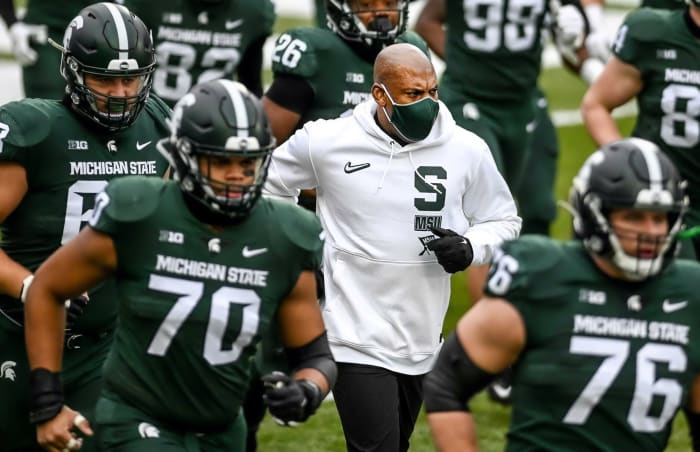
MSU's reality: Tucker got paid, swimmers and divers saw their sport cut.
Nick King/Lansing State Journal/USA TODAY Network
Beekman told the gathered athletes that "the pandemic didn't help. That's not the sole logic. But it didn't help." In a press release, Michigan State cited the lack of "a regulation size pool in which to even train." This was false; MSU does have a 25-yard pool that meets NCAA guidelines. What it does not have is a 50-meter pool, as many of its Big Ten counterparts do—and rather than upgrade facilities, a school that this year paid more than $12 million to head football coaches alone decided to shut down its swimming and diving programs.
These are relatively inexpensive sports; one might wonder why they need to be cut permanently to deal with the massive but temporary problem of the pandemic. But the number of varsity swimming programs has been shrinking for years. Cries of poverty are an excuse.
"I think it's an easy out for them," says former Olympian and current NBC swimming commentator Rowdy Gaines. "Just be honest and say, These are the sports we need to cut because we don't need them, we don't want them and they don't do anything for us. Call a spade a spade, for crying out loud. Quit lying to us."
When former Big Ten commissioner Jim Delany created the Big Ten Network less than a decade ago, he was adamant that it would largely benefit the league's nonrevenue sports by giving them increased exposure. That proved to be true. But that exposure was an ancillary benefit. The impetus for forming the network was simple: money. Last year, the network distributed $54 million to each of the conference's 12 longest-standing members (while newbies Maryland and Rutgers got smaller checks).
Treating revenue sports as businesses and nonrevenue sports as luxuries leads to some embarrassing allocations of resources. Two of many such examples: Over the summer, after numerous Black players accused the Iowa football team's strength coach, Chris Doyle, of mistreatment, the school agreed to pay him $1.3 million to leave. (Doyle denied the allegations.) Two months later, the Hawkeyes cut men's gymnastics, men's tennis and men's and women's swimming and diving because of a budget crunch. Unlike Doyle, several of the women's swimmers are suing (on Title IX grounds)—and last week they were granted an injunction that keeps the team alive for now. And in October, less than a year after Minnesota gave football coach P.J. Fleck a million-dollar raise, to $4.6 million, the school's board of regents voted to cut three men's programs: gymnastics, tennis and indoor track and field.
Stanford has long been the model of excellence across sports; in 2017, athletic director Bernard Muir proudly told the San Francisco Chronicle, "We have 36 sports, and we're trying to improve in each and every one of them." But this year, the Cardinal cut 11 sports, which is an unconventional method of improving them. Muir joined the school's president and provost in releasing a statement that read: "The financial model supporting 36 varsity sports is not sustainable. The average Division I athletics program sponsors 18 varsity sports."
Any administrator worth his courtesy car can explain away all the decisions. They will say that large salaries or buyouts are funded by "private donations," and that they had to make tough calls about nonrevenue sports because of the massive revenue shortfall of a year with no ticket sales. And as business decisions, based solely on return on capital, many of these calls make sense.
But those same administrators have spent decades claiming that they are not running professional enterprises. The pandemic revealed how fraudulent that argument really is.
Twenty-one years ago, when Nick Saban left Michigan State for LSU, he became one of just a handful of coaches earning seven figures. This year, four Ohio State assistants made at least $1 million apiece. The issue here is not one of economics. It is a matter of mind set. College football has grown so big that it dwarfs almost everything else. Departments are judged by the performance of one or two teams, and the people running those departments act that way. Nobody takes an athletic-director job to hire a volleyball coach.
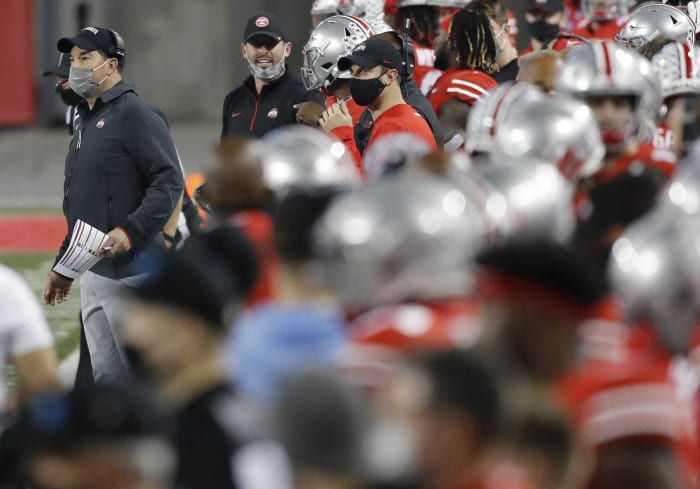
How serious is the college football money? At Ohio State, four of Ryan Day's assistants earn over $1 million each.
Adam Cairns/Columbus Dispatch/USA TODAY Network
"I hate saying this, but I really believe that most—not all—athletic directors only want football and basketball," says Gaines. "If you backed them into a corner and put them to a lie detector test, they'd fail miserably if they said they loved these other sports. They are just a headache. ADs want them to go away. They've got enough to worry about with football and basketball. Why worry about crew? Why worry about gymnastics? They're a weight around my neck. I gotta show up at their meets and I gotta pretend I like them—and I don't."
College sports will change radically over the next 20 years. The question is how? Rules allowing athletes to profit off their names, images and likenesses are coming—rules that are both fair and overdue. But if 2020 is any indication, then without even the pretense of amateurism, athletic departments will continue to detach themselves from the central mission of their schools.
The NCAA's longtime model of using football and men's basketball to fund other sports was always legally and morally suspect. But this pandemic-altered year showed it was also just a cover. Football will get bigger, because that's what the marketplace demands. Everything else—rivalries, traditions, nonrevenue sports, academics—will fit around that fundamental truth.
On the 337th day of 2020, the Michigan State athletic department convened a Zoom meeting to discuss its preliminary "strategic plan" for the next 20 years. It includes a new football facility to replace the one that the school opened in '08.



